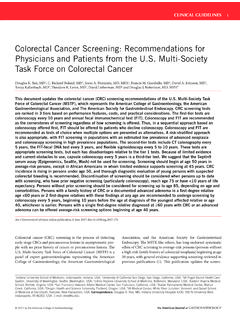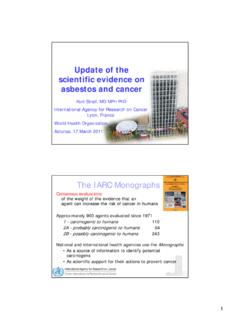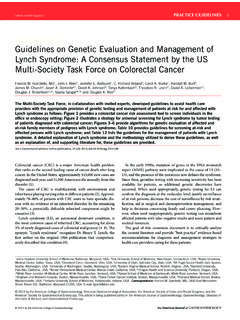Transcription of Improved Survival Rates With Addition of HAI …
1 A Little Ingenuity with a Big ImpactCODMAN 3000 implantable drug delivery system provides continuous hepatic arterial infusion (HAI) of chemotherapy directly to the site of the tumor. Reliable, accurate drug administration Large, domed, single-septum access Easy access pathway for bolus procedures Secure needle retention for bolus infusions Easy to refill Smooth contours for patient comfort Totally implantable Improves patient s freedom of mobilityTargeted Drug Delivery: Improved Tumor Response1 HAI therapy allows the administration of regional chemotherapy and demonstrates a trend toward increased ,3 Regional chemotherapy increases time to progression4 HAI therapy enhances quality of life3 Recent clinical research reports that liver resection and regional chemotherapy in combination with systemic chemotherapy shows an Improved trend toward survival2 HAI Patient Selection Criteria5 Liver metastases from colorectal cancer Radiographically documented absence of extrahepatic tumor Appropriate arterial anatomy documented by angiography Portal vein patency Absence of infection Model 3000 - 30 mLHAI Therapy Provides the Potential for Improved 2-Year and 5-Year Survival Regional hepatic chemotherapy significantly improves the control of local disease in patients who undergo resection of liver metastasesfrom colorectal cancer.
2 The use of HAI plus systemic chemotherapynot only decreased the rate of hepatic recurrence but also Improved two-year overall Survival , as compared with the use of systemicchemotherapy alone. 2 Adjuvant Chemotherapy Provides Significant Control of Liver Tumor Recurrence Following Liver Resection 6 Combined Therapy Resection AlonePValue4-year Recurrence Rate46%25% Recurrence-Free Rate67%43% months49 Combined Therapy = Hepatic resection + regional FUDR ( mg/kg/day) (HAI) + systemic 5-FU (200-300 mg/m2) for 14 days. 75 of the 109 patients enrolled in the study were assessable..adjuvant intra-arterial and intravenous chemotherapy [is] beneficialin prolonging time to hepatic resection of colorectal cancer. 6 High Tumor Response Rates in Patients with Unresectable Liver Metastases 74% tumor response rate in patients treated with HAI therapy + systemic chemotherapy who were not eligible for liver resection7 Regional FUDR ( mg/kg/day) for 14 days + systemic irinotecan (100 mg/m2) for 21 days (non-cryosurgery patients).
3 Randomized Trials of HAI*vs Systemic Chemotherapy for Colorectal Liver MetastasesStudyRegimenPatientsResponse (%)Key PointsMSKCC8 HAI: FUDR ( with Pump)4850%Allowed crossover(1987)IV: FUDR5120%NCOG9 HAI: FUDR ( with Pump)5042%Allowed crossover(1989)IV: FUDR6510%MAYO10 HAI: FUDR ( with Pump)3348%First study to use(1990)IV: 5-FU3621%IV 5-FU control arm1 Lorenz et : FUDR ( with Port) 5443%31% did not receive(2000)HAI: 5-FU/LV ( with Port) 5745%planned HAI treatmentIV: 5-FU/LV 5720%MSKCC = Memorial Sloan-Kettering Cancer Center. NCOG = Northern California Oncology Group. HAI = Hepatic arterial infusion. IV = Systemic infusion. FUDR = Floxuridine. 5-FU/LV = 5-fluorouracil + leucovorin.*Studies used a mg/kg/day dose of FUDR in pump. Study used a mg/kg/day dose of FUDR reduced after 3 cycles to mg/kg/day for 14 days every 28 days.
4 5-FU (1000 mg/m2) continuous infusion for 5 days + leucovorin (200 mg/m2) bolus for 5 days every 28 Can Enhance Quality of Life A randomized trial by Allen-Mersh et al demonstrated that quality of life can be significantly Improved for patients with colorectal liver metastases who receive HAI therapy vs no treatment or systemic therapy alone3 Regional FUDR ( mg/kg/day).Factors Influencing Successful Use of HAI Therapy5 Surgical ligation of collaterals to the stomach and duodenum Intraoperative perfusion of fluorescein dye to document liver perfusion, catheter placement, and missed collaterals Routine cholecystectomy to avoid drug-induced cholecystitis Postoperative HAPS study prior to initiation of HAI chemotherapy Careful monitoring of liver function tests (SGOT, alkaline phosphatase, bilirubin) with appropriate dose reduction or withholding of FUDRI mproved Survival Rates with Addition of HAI Therapy2 Study EndpointsCombined Therapy (n=74)*Monotherapy (n=82) 2-year Median Survival86%72%5-years (Actuarial)61%49%2-year Disease-Free Survival90%60%Median Disease-Free SurvivalNot yet months5-year Disease-Free Survival74% (23 patients)
5 44% (21 patients)*Combined Therapy = Hepatic resection + regional floxuridine(FUDR) (actual dose delivered mg/kg/day) (HAI) + systemic 5-FU (325 mg/m2) + bolus leucovorin (200 mg/m2). Monotherapy = Hepatic resection + systemic 5-FU (370 mg/m2) + leucovorin (200 mg/m2). There s Something Inside Making a Big ARTERIAL INFUSION FOR COLORECTAL LIVER METASTASES 2003 Codman & Shurtleff, Inc. All rights :1. Skitzki JJ, Chang AE. Hepatic artery chemotherapy for colorectal liver metastases: technical considerations and review of clinical trials. Surg ;11:123-135. 2. Kemeny M, Huang Y, Cohen AM, et al. Hepatic arterial infusion of chemotherapy afterresection of hepatic metastases from colorectal cancer. N Engl J ;341:2039-2048. 3. Allen-Mersh TG, Earlam S, Fordy C,Abrams K, Houghton J.
6 Quality of life and Survival with continuous hepatic-artery floxuridine infusion for colorectal liver ;344:1255-1260. 4. Kemeny NE, Ron IG. Hepatic arterial chemotherapy in metastatic colorectal patients. Semin ;26:524-535. 5. Venook AP. Update on hepatic intra-arterial chemotherapy. Oncology. 1997;11:947-954,957. 6. Kemeny MM,Adak S, Gray B, et al. Combined-modality treatment for resectable metastatic colorectal carcinoma to the liver: surgical resection of hepaticmetastases in combination with continuous infusion of chemotherapy an intergroup study. J Clin ;20:1499-1505. 7. Kemeny N,Gonen M, Sullivan D, et al. Phase I study of hepatic arterial infusion of floxuridine and dexamethasone with systemic irinotecan for unresectable hepatic metastases from colorectal cancer.
7 J Clin ;19:2687-2695. 8. Kemeny N, Daly J, Reichman B, Geller N,Botet J, Oderman P. Intrahepatic or systemic infusion of fluorodeoxyuridine in patients with liver metastases from colorectal carcinoma: a randomized trial. Ann Intern ;107:459-465. 9. Hohn DC, Stagg RJ, Friedman, et al. A randomized trial of continuous intravenous versus hepatic intraarterial floxuridine in patients with colorectal carcinoma metastatic to the liver: the Northern CaliforniaOncology Group Trial. J Clin ;7(11):1646-1654. 10. Martin JK, O Connell MJ, Wieand HS, et al. Intra-arterial floxuridine vssystemic fluorouracil for hepatic metastases from colorectal cancer: a randomized trial. Arch ;125:1022-1027. 11. Lorenz M,M ller H-H, for the German Cooperative Group on Liver Metastases. Randomized, multicenter trial of fluorouracil plus leucovorin administered via hepatic arterial or intravenous infusion versus fluorodeoxyuridine administered via hepatic arterial infusion in patients with nonresectable liver metastases from colorectal carcinoma.
8 J Clin ;18(2):243-254 Reimbursement Assistance Program To speak with a qualified reimbursement representative for information and assistance on reimbursement and precertification, call toll-free 1-800-609-1108, Monday through Friday, from 8:30 AMto 5 To order any of the following accessories, please call Arterial Catheters:AP-07003: Barbed Catheter Connector AP-01006: A Port Implantable Vascular Access System ( mm ID x mm OD)Pre-Attached Silicone Catheter with 3 Suture Beads AP-01007: A Port Implantable Vascular Access System ( mm ID x mm OD) Detached Silicone Catheter with 3 Suture Beads Pump Refill Supplies:AP-07014: Model 3000 Series Refill KitAP-04009: Non-Coring Refill Needle, 22 gauge x 1 , Straight AP-04011: Non-Coring Refill Needle, 22 gauge x 11/2 , Straight AP-04030: Non-Coring Refill Needle, 22 gauge x 2 , Straight Special Bolus Needles:AP-04013-5: Special Bolus Needles, 13/8 , Straight AP-04032-5: Special Bolus Needles, 2 , Straight AP-04033-5: Special Bolus Winged Infusion Set, 11/2 , 90 AngleAP-04034-5: Special Bolus Winged Infusion Set, 13/4 , 90 Angle For additional information and assistance, call CODMAN Customer Service at 1-800-225-0460 orour 24-hour Technical Support Service at 3000 Delivers Reliable Single-Septum AccessPump Refill ProcedureRefill PathDrug Reservoir: available in 16, 30, and 50-mL sizesPropellant Chamber.
9 No batteries required (lifetime warranty)22-Gauge Non-Coring Refill NeedleBolus InjectionFilterNeedle StopFlow RestrictorDomed Septum: easy to locate for bolus accessPump CatheterPump CatheterSafety ValveSafety Valve SpringBolus PathDomed Septum: easy to locate for refill accessSafety ValveSafety Valve SpringSpecial Bolus NeedleFilterFlow RestrictorNeedle StopSmooth Contours: increased patient comfort and decreased pocket erosionSmooth Contours: increased patient comfort and decreased pocket erosionThe CODMAN 3000 is indicated for the continuous regional delivery of 2-deoxy-5-fluorouridine (FUDR) and glycerin as a Flow Rates AvailablePump ModelLabeled Intra-Arterial Flow Rate* 16-mL mL/day30-mL mL/day50-mL mL/dayGlycerin Infusion as Placebo During Interruption of HAI Chemotherapy in the CODMAN 3000 PumpPump ModelLabeled Intra-Arterial Flow Rate*Approximate Refill Interval 16-mL ReservoirHigh55 to 62 days30-mL ReservoirHigh79 to 87 days50-mL ReservoirHigh66 to 79 days*Nominal flow Rates are defined as the typical clinical flow rate in mL/day.
10 The nominal or typical rate is defined at standard conditions: patient temperature F; altitude sea level. Arterial manufactured flow Rates are adjusted for arterial pressure (100 mm Hg with 1000 IU/mL heparin). Flow Rates cited here are for CODMAN 3000 high-flow pumps. 50% glycerin solution. Refer to CODMAN 3000 glycerin instructions for refill period 6/03 CH/MGFor more information, contact your Codman Drug Delivery Sales Representative325 PARAMOUNT DRIVE RAYNHAM, MA 02767 (508) 880-8100 FOR PRODUCT INFORMATION, CALL: (800) 225-0460







